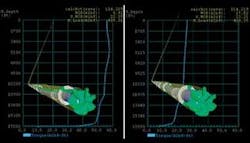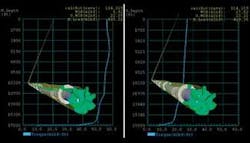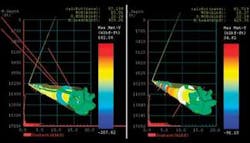Faster drilling optimization process
The i-DRILL drilling optimization software program recently developed by Smith Technologies can assist drilling engineers with a dynamic analysis of the total drilling system to minimize risk and cost. This optimization can be defined as “identifying the most favorable or best possible conditions for a process,” and it is particularly critical in these times of increasing drilling costs and limited rig availability.
Visualization of any drilling process is a powerful tool. Analogous to the state-of-the-art 3D visualization rooms built to give reservoir engineers the ability to “see” the reservoir and identify hydrocarbons at depth, this software program gives the drilling engineer the ability to “see” a drillstring in action and to identify detrimental vibrations and to recognize unacceptably high forces on the drillstring.
Historically, the industry’s primary means of improving drilling performance in a field has been to adopt conservative, proven drilling practices on the first well, and then make small, incremental changes in subsequent wells over time to drive down the cost of each well as drilling progressed. By the time an operator drills the last well, the cost per foot is far below the cost for the first well as a result of the cumulative learning.
Trial-and-error
Although industry’s trial-and-error process works, the approach is inefficient and costs are much higher because of wells drilled using less than optimized methods.
Many drilling professionals have had their own visions of what a drill bit and steerable assembly look like at 10,000 ft as the PDC bit drills through shale at 75 ft/hr ... mostly chaotic, hot and churning, steel and mud. Unusual downhole equipment wear patterns, such as damaged collars and stabilizers, cracked connections, and broken circuit boards inside of MWD collars, fueled speculation and imagination regarding what caused these problems.
Since the pace of drilling activity has increased to its current level, industry’s shortages of qualified personnel and a general lack of experienced talent has made the trial-and-error approach even more difficult to implement. Engineers and managers alike are more dependent upon consultants and less-experienced personnel to develop drilling programs.
With experience levels down, industry’s prudent approach is to choose conservative drilling practices, minimize changes, reduce uncertainty, and minimize risk. This approach causes drilling performance to suffer, and it becomes increasingly difficult to stay ahead of the planned days vs. depth curve. Drilling engineers and consultants are judged typically by their daily footage and nobody wants to sit through the morning meeting with a real “dog” of a well, woefully behind, with little chance to ever catch up.
Even with today’s powerful desktop PCs and laptops with dedicated software design packages, industry has limits to what can be done to optimize drilling and control risks. Industry’s conventional approach has been to use software programs that focus on analyzing individual elements of the drilling system rather than the total drilling system - from the drill bit as it contacts the formation all the way up to the drive mechanism at the surface.
Paradigm shift
With the recent development of drilling optimization software, the paradigm has shifted from trial-and-error optimization and the analysis of individual drilling subsystems to an integrated dynamic analysis of the total drilling system. Using this software program can identify specific damaging processes in a variety of drilling applications and permit multiple simulations to find solutions before the next well is drilled. This program is a descendant from the integrated dynamic engineering analysis system (IDEAS) software, which enables dynamic visualization and virtual prototyping. The current program is a planning tool providing insight into what is happening downhole by simulating the performance of the bit, BHA components, and drillstring.
Identify, investigate
Typical areas of investigation include: 4D (i.e. three physical dimensions as a function of time) dynamic simulations of different bit and BHA combinations, and their resulting drilling processes; roller cone and PDC bit performance in differing lithologies as a function of weight on bit and RPM; and quantitative axial and frictional forces in the drillstring as well as axial and frictional torque values anywhere in the drilling assembly.
Also through virtual simulation in any BHA it can identify the best system before the well is drilled using a comprehensive library of roller cone (milled tooth and TCI) and PDC bits, along with numerous drilling components, including some of the most sophisticated rotary steerable systems (both push- and point-the-bit configurations). This allows experimental “what if” scenarios to be tested in the office, minimizing risks and costs at the well-site.
Initially, the company’s IDEAS program for drill bits consists of a dynamic finite element analysis suite to allow design engineers to test the limits of tool design. This program can optimize bit cutting structures and materials of construction for very specific applications in a fraction of the time it used to take through the traditional “design, build, and then test” method. Additionally, the resulting bit represents a near-ideal solution, with an optimized combination of speed and durability to meet the specific application requirements. In another words, the bits represent fit-for-purpose technology aimed at improving performance in the most challenging drilling situations.
Because the design concepts are accurately modeled and performance-tested in a simulated environment before being built and run downhole, bit designers have the freedom to be bolder and more creative without exposing operators to undue risk.
IDEAS to i-DRILL
To take IDEAS to the next level meant broadening the dynamic finite element analysis software to accommodate each component of the entire drillstring, which includes any type of stabilization, drill collar, steerable motor, shock sub, etc. in the proposed BHA. The optimization engineer is free to try new assemblies in a simulated environment.
Since May 2004, company engineers have successfully completed a variety of optimization projects. Drilling applications where the analysis software recommendations have made a positive contribution during the planning phase include:
- Substantial ROP improvement through bit design comparisons
- Comparing and validating dynamic behavior of different BHAs
- Matching bit and under-reamer performance
- Vibration and stick-slip analysis and mitigation
- Dynamic bending stress evaluation
- Directional tendencies of a variety of BHAs
- Identification of optimum RPM/WOB combinations
- Analyze WOB distribution in directional and horizontal wellbores.
Dynamic vs. static
The company acknowledges that for years drilling engineers relied upon steady state or static analysis to help design drilling assemblies and improve drilling performance. Engineering assumptions had to be made to accommodate the limited capabilities of smaller, less powerful computer processors, and this compromise meant less-than-accurate methodology. Without the ability for company engineers to understand the importance of bit/rock interaction forces at each individual cutter location along with the BHA, and drillstring behavior as a function of time, variations in the system and the specific combinations of tools/parameters that cause them could not be identified.
With the industry’s introduction of downhole “smart” sensors that measure and record WOB, torque, RPM, and vibrations in and near the BHA during the drilling process, an improved understanding of these parameters as a function of both depth and time is possible. The industry’s ability to plot these parameters against MD/TVD and subsequently analyze of the data led to understanding the active processes and forces present in the drilling system not only as a function of time but directly related to the characteristics of the rock being drilled.
The company uses surface data (and in some cases the corresponding downhole parameters) in the simulation software to increase the accuracy of the virtual model. This gives a clearer understanding of the relationships between the downhole and surface data sets, which is especially important in directional and horizontal applications. Tracking the frequency and amplitude of downhole measurements is not only possible, but is a critical part of understanding and predicting drillstring, BHA, and bit behavior.
Simulation process
Using qualified offset well data, the company can construct a model of the offset wellbore and drillstring inside a computer workstation with massive memory storage capacity and multiple processors. The company surveys, hole caliper, drillstring component dimensions, BHA, and bits are reproduced, so the model can reproduce the surface and downhole parameters actually recorded in the offset. This results in a calibrated model ready to support the optimization process.
Through the collaborative efforts of the company engineering team and the operator drilling engineers, challenges are identified and priorities established that lead to the identification of damaging processes for their elimination. Ultimately, after hundreds of dynamic simulations, the company’s best system is fine-tuned and recommended through video clips illustrating offset vs. optimized performance along with binders full of the engineering data supporting the ideal system. The company detail is further supported by best practices in terms of WOB and RPM combinations (including sensitivity analysis) to produce optimum performance.
Optimized drilling
The operator can drill the subject well using the optimized system, at which time attention is focused on ensuring that planned parameters are maintained, and performance is monitored. The company collects the surface data and, in some cases, downhole data concurrently to support the post-well validation phase that marks an i-DRILL project’s final phase. This review typically identifies opportunities for additional improvements in subsequent operations. Savings generated by eliminating or minimizing problems such as connection repair/failures, and MWD/LWD and/or rotary steerable system failures (typically vibration induced), coupled with the often superior ROP achieved through the synergy of the optimized drilling assembly has been significant for both land-based and higher cost offshore drilling operations.
Recently, the company applied the drilling optimization software program to an operator with a shallow-water development well using a rotary steerable system while under-reaming. The operator encountered drilling problems such as high stick-slip and lateral vibration, MWD/LWD and RSS tool failures, and had to replace three BHA’s to reach total depth.
Goals of the application were to: identify causes of vibration, design optimum BHA, select best performing bit, identify optimum reamer placement, specify optimum drilling parameters, and reduce NPT.
The company then constructed a model of an offset well-bore and drillstring inside a computer workstation with massive memory storage capacity and multiple processors using the qualified offset well data.
Through the collaborative efforts of company engineers and the operator drilling engineers, challenges were identified and priorities established that led to the identification of damaging processes and their methodical elimination.
Mark Frenzel, Smith Technologies


